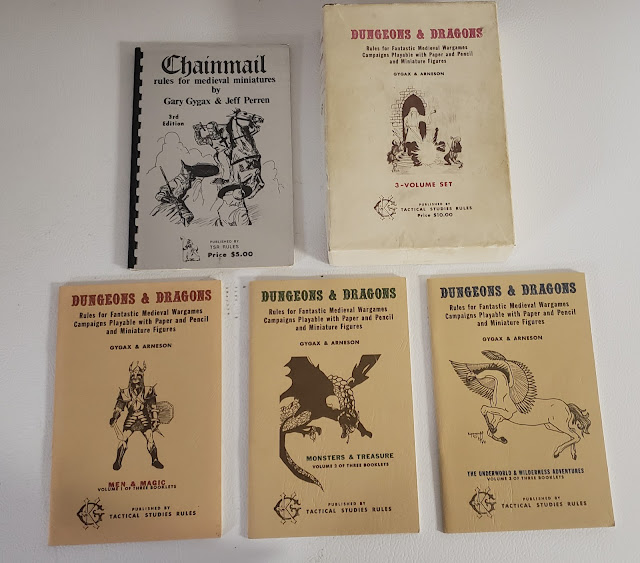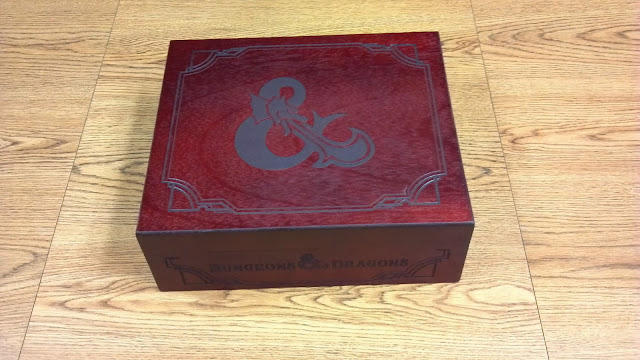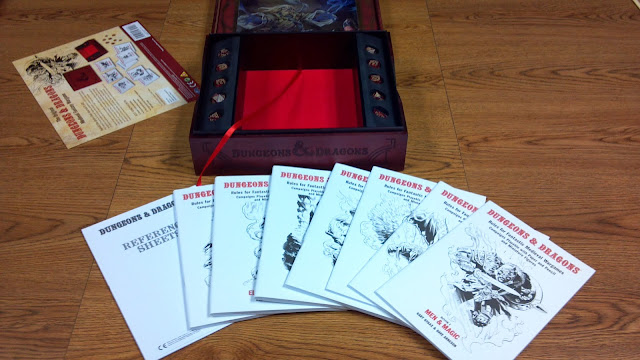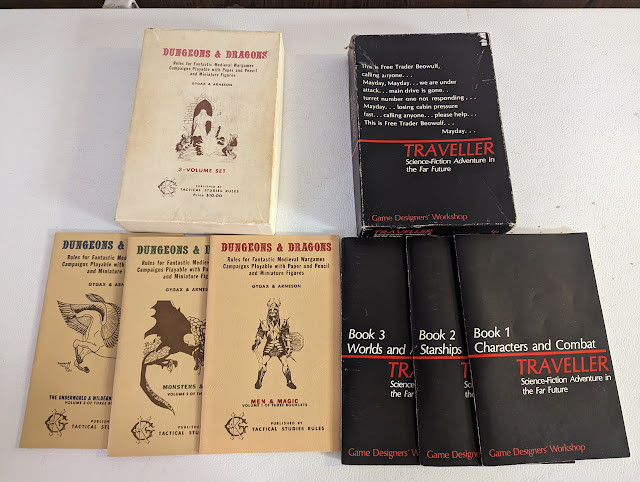While working on my post for earlier today on Dungeons & Dragons 4th Edition, I can't help but think about the lost opportunities that game had. I read through the books and they are barely used compared to my 1st and 5th Edition books. Though if you scratch the surface of 5e you will find some 4e DNA.
It is too bad, really, since 4e had a lot going for it. Or maybe I had invested a lot in some of the ideas that came out at the same time as 4e. I mean, if I am honest, there isn't anything I can do in 4e that I also couldn't do in 5e or BECMI, really. In any case, while going over my 4e materials, I did uncover all sorts of neat ideas. After all, this edition gave birth to my warlock character Taryn.
But I am not here to talk about Taryn. I am here to talk about her mother, my witch Larina.
Witches in D&D 4e
4e is notable for giving us a proper witch class in Heroes of the Feywild. Well...it is a type of Wizard, but one that learned in the Feywild, aka D&D's Land of Faerie. Honestly, that works for me. I mean, I know Larina spent a long time in the Feywild, met the Faerie Lord Scáthaithe, and gave birth to Taryn. So doing all my D&D 4 playing in the Feywild would work, it would explain why magic is different in this edition.
So that all works. I know I am going to get a warlock out of the process with Taryn, but what else? I spent some time here stating up some characters for 4e and 4e Essentials, but character building by hand with this game, especially a high-level character, is a long process. It was a fun process, don't get me wrong, but long. I just forgot how many character options there are for later 4e characters.
Here are some of the characters I did when 4e was still active. There are few witches here along with some classics.
- Aleena, the Cleric from D&D Basic (Mentzer)
- Morgan Ironwolf, the Fighter from D&D Basic (Moldvay)
- Hex, the Dark Elf witch from Skylanders
- Skylla, the "Evil Magic-user" from the D&D toy line.
- Eireann, a "proto-Sinéad" concept who now has a life of her own.
While these each took some time, each one was a really fun build. So much, really, that I could see myself running some sort of one-shot for 4e set in Feywild. I will get to doing stats for Sinéad and Taryn for 4e when I discuss the 4e Forgotten Realms.
Larina Nix for 4e
Larina is, as always, a test-bed character for me. In 3e when I first started I tried her out as an "out of the box" sorcerer. When 4e came out I tried her as a Warlock. But Larina is no sorcerer and certainly not a warlock. I know these differences are largely academic, but I am the academic who cares about them.
Thankfully my 4e experiments could move on with Taryn who IS a warlock. Eventually, the Heroes of the Feywild book came out and solved my problems.
For this build, I am going to use the following books.
Heroes of the Feywild is the main book, but I am also taking powers, feats, and ideas from the others. There are other books I could have used, but I wanted to limit myself to these. There is a third-party witch book, World of the Witch, that is quite good, but I wanted to stick to the official WotC books this time.
For this build, I went all out. This is Larina as a 30th-level Queen of Witches (the Epic Destiny in the book). I figured...what the hell, go fo it.
Given that in 4e, newer powers replace older ones, I just built the character backward. So, I started at what she gets as the 30th level and worked my way down. I didn't have to do a lot because while going through all my notes and character sheets, I found character sheets for her at 1st (several of these), 7th, 13th, and 25th levels. Differences exist between all of these, but all in all, I got a pretty good picture of what I wanted to do.
Larina Nix, Witch Queen30th-level Female Human Witch (Wizard)
Unaligned (Lawful Neutral)
Class: Witch (Full Moon Coven)
Paragon Path: Legendary Witch
Epic Destiny: Witch Queen
Abilities
Strength: 12 +1
Constitution: 16 +3
Dexterity: 16 +3
Intelligence: 22 +6
Wisdom: 22 +6
Charisma: 20 +5
Combat
Initiative: +18
Speed: 6 (30ft)
Hit Points: 155
Bloodied 77
Healing surges: 38hp
Defenses
AC: 36
Fortitude: 33
Reflex: 36
Will: 38
Vision: Normal
Passive Insight: 31
Passive Perception: 31
Skills
Acrobatics +18, Arcana +29, Athletics +16, Bluff +23, Diplomacy +24, Dungeoneering +21, Endurance +18, Heal +28, History +26, Insight +21, Intimidate +25, Nature +21, Perception +21, Religion +26, Stealth +18, Streetwise +20, Thievery +18
Feats
Human: Linguist, Toughness, Implement Focus, Fey Bond, Combat Medic, Armor Proficiency: Leather, Skill Focus: Arcana, Improved Defences, Familar Utility, Enlarge Spell, Arcane Resources, Ritual Caster, Arcane Mastery, Irresistible Flame, Arcane Fire, Pact Initiate: Warlock (Fey), Spell Accuracy, Nightmare Wizardry, Arcane Ritualist
Features
Familiar, Witch Cantrips (3), Bonus Skill: Healing, Full Moon Coven, Favor of the Moon, Move Coven Action, Witch Apotheosis, Witch Queen Presence, Pact Initiate (Fey Pact Warlock)
Languages
Common, Goblin, Elven, Draconis, Primordial, Sylvan
Powers (Spells)
Cantrips
Light, Mage Hand, Prestidigitation
At-will
Bonus: Ray of Frost, +6 vs Fortitude, 2d6+6 cold damage
Breath of Night, +6 vs Fortitude, 2d10+6 damage
Witch Bolt, +6 vs Reflex, 2d10+6 damage
Encounter
Warlock: Eye Bite, +5 vs Will, 2d6+5 psychic damage
Madness of the Full Moon, +6 vs Will, 2d10+6 psychic damage
Night Tempest, +6 vs Fortitude, 2d8+6 cold damage, knocked back 5 squares
Chain Lightning, +6 vs Reflex, 4d6+6, 2d6+5, 1d6+6 lightning damage
Supreme Glorious Presence, +6 vs Will, 4d6+6 damage, target knocked back, Allies heal
Daily
Acid Wave, +6 vs Reflex, 5d6+6 acid damage, 10 ongoing
Unicorn Form, Polymorph, secondary 5d8+6, push 1 square
Prismatic Wall
Herbal Healing
Evanesce
Witch Thorns
Moonlight Mischief, teleport 6 squares
Ride the Night Wind, Fly 8, +2 to Reflex
Umbral Stride, phase, move 10 squares
True Prophecy, +2 to all rolls
Rituals
Arcane Barrier, Comprehend Language, Consult Mystic Sages, Consult Oracle, Enchant Magic Item, Eye of Warning, Guards and Wards, Hand of Fate, Magic Circle, Magic Map, Object Reading, Remove Affliction, Telepathic Bond, Wizard's Sight
Equipment
Staff, books, dagger, shoulder bag, leather armor +6, Bracers of Defense, Ring of Wizardry, Cloak of Feywild Escape, Broom of Flying, Elven Boots
--
So I really like this build. If I were still playing 4e I might house rule that some of the other witch spells from other games could be rituals. That is the easiest way to bring them in.
She has a lot of feats, just the reality of 4e. But I was able to do some interesting things with them that have great in-universe and in-character explanations. Linguist and Toughness are the ones she always takes. She is the party translator and "face." Because of that she is usually in front where the action is, so she needs to survive long enough to be powerful enough on her own. Feats to make her magic more potent, to be more fiery, and things like that.
But two in particular are really fun. Fey Bond and Pact Intitate. I had plans to do a Feywild-centric set of adventures for some time. The more I work on 4e versions of Larina, Taryn, and Sinéad, the more I want to do it, and do it with 4e. These two feats then represent her time in the Feywild and her bond with Faerie Lord Scáthaithe, who would become the father of her daughter Taryn and Taryn's Warlock Patron. I know I said above that Larina was a lot of things, but no warlock. Well... a lot of her earlier sheets were warlocks. The way 4e does multi-classing is very different than the other versions of D&D, so it's not like she is a true Warlock, just a dabbler.
.png) |
| Scáthaithe the Knight of Swords and a young Larina |
I look forward to digging up my 4e sheets on Taryn and making some new ones for Sinéad.
Maybe I should get that Feywild 4e game going sometime. That sounds like a lot of fun.




















